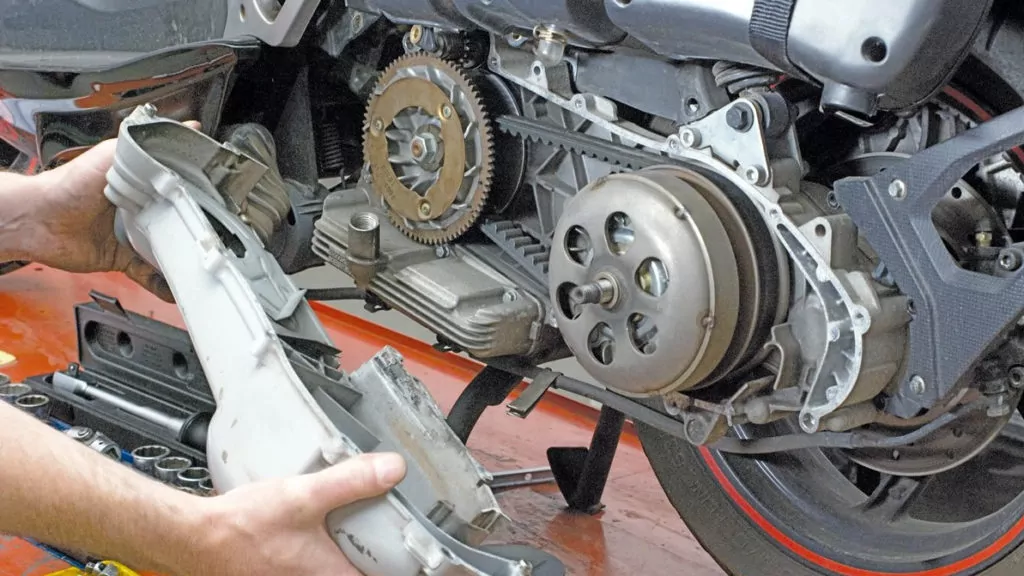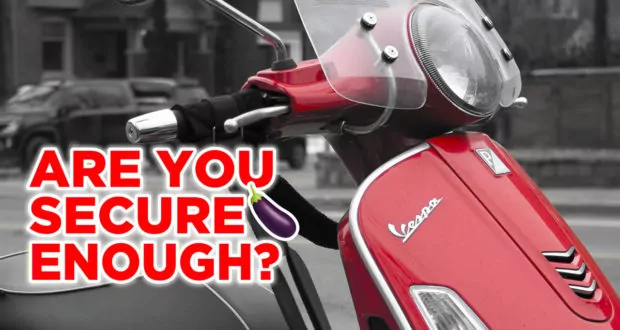The Vespa GTS 300 is a fantastic scooter with a nice finish. Vespa is one of the most iconic brands in the world, but they remain kind of a weird cousin in the motorcycle world and aren’t necessarily for everyone. In this review we’ll look at some of the reasons why you may want to consider buying a Vespa GTS 300, and some of the reasons why this scooter may not be for you.
A Vespa GTS 300 would be perfect for you if you’re looking for a simple, reliable, retro-inspired vehicle, with a comfortable step-through frame, no need for shifting gears, and comfortable cruising up to around 70 miles per hour.
Here’s a video review of the GTS 300 if you prefer watching your motorcycle content instead of reading it:


If you want more details, here’s a review of the Vespa GTS 300 that will help you to quickly understand whether or not this is the right scooter for you. This review will be covering the following:
- Step-through frame design
- Speed
- Automatic CVT transmission
- Maintenance
- Miscellaneous (Fuel economy, storage, weight)
- Who should NOT buy this scooter
- My tip for anyone interested in buying
Step-through frame
The first thing that separates a motorcycle from a scooter is the step-through frame. I’m putting it first because for a lot of people, this is either a decision-maker, or decision breaker.
The step through frame can be excellent for people with disabilities, injuries, or any kind of mobility issues. It gives people the ability to start riding, or keep on riding, in spite of whatever they have going on. It could also just make them feel more comfortable, and that’s okay too.
However, if what you really want is a bad ass motorcycle, the step-through frame may not be right for you. Not only that, but hooligan riders might find it difficult to exercise the same amount of fine control you’re used to from a motorcycle you can wrap your legs around. It’s not that a GTS lacks good handling, it’s just that you won’t have the same precision handling that you might be used to at high speed. It’s not made for that.
Speed
Speaking of speed, a lot of people will ask you “Is that thing safe to take on the highway?” The answer is yes, and no.
For those who want to do light highway duty, good news: This Vespa will tell you that it goes 88 miles per hour, or about 141 km/hr. Keep in mind, that the speedometer a little overly optimistic. In reality, the Vespa GTS 300 will do a GPS verified 77 miles per hour, or about 124 km/hr. At that point the Vespa seems to have some sort of limitation put in place from the factory. Still though, my old commute used to put me on the highway for two or three exits and then I would jump off. For that short travel, this Vespa would do just fine.
But 77 mph, or 124 km/hr isn’t really all that impressive, is it? And maybe that’s not a bad thing. After all, it’s riding on 12” wheels across a 54” wheelbase. The GTS 300 is relatively stable on the highway in spite of it’s design, not because of it. And should you ever find yourself on the highway needing to quickly get out of the way of trouble behind you, well, you might be stuck there because your top speed is capped.
UPDATE: There’s a kit available from Vespa Motorsport that will allow you to remove the restriction and get your Vespa up to an indicated 81 mph, or about 130 km/hr. You can learn about it here:
Automatic transmission
The GTS 300, like pretty much all Vespas since the PX around 2005, uses automatic CVT transmission. There’s no shifting gears, and no clutch to play with. It’s a very simple system.
For new riders, or the easily intimidated, having less to worry about means a more easy to use, welcoming motorcycle. As someone who’s been riding almost my life, honestly, when I’m stuck in downtown stop and go traffic, on my commute home from work, the CVT transmission is actually kind of nice. I don’t miss shifting on the commute home.
However, once again, for hooligan riders, and even average gearheads, outside of commuting in traffic, you probably won’t care for the automatic CVT the rest of the time.
The CVT transmission also makes things a little different from a mechanical perspective: There’s a belt that you can’t see or know when it’s about to tear on you. There are pulleys, but not the kind that we’re used to. There’s a variator. Things are just very weird and it’s a whole other animal to learn how to maintain and modify than what you might be used to on a motorcycle. It’s a new type of drive-train to learn about for the uninitiated.

Maintenance
However, there’s an upside to this Vespa GTS not having a traditional chain-driven final drive system, it’s a pretty low maintenance vehicle. Change the oil every 4,800 km (3,000 miles), and change your pulleys and belt every 10,000 to 12,000 km (6,000 to 8,000 miles).
But that low-maintenance easy-breezy air about the Vespa might give you a false sense of confidence that can leave you stranded. The drive belt the Vespa GTS 300 uses won’t last you anywhere near as long as that of a cruiser. You definitely want to replace the belt every 6 to 8,000 miles because I have a few friends who have neglected it and totally lost power in the middle of their ride and ended up stranded.
All of the other little cutesie stuff
And then there’s all of the other little cutesy stuff.
The GTS 300’s 278cc single cylinder engine gets 65 to 70 mpg, or 25% to 30% better fuel economy than a Prius. You can store stuff underneath the seat. It comes with disk brakes, ABS, and traction control. For $20 you can upgrade to some Malossi rollers that will significantly improve your acceleration. And let’s be honest, this thing is a classic. It’s beautiful now and will still be considered beautiful in 50 years.
And then there’s all of the little stuff:
- It isn’t a motorcycle.
- People won’t be mistaking you for a bad ass even if you are one.
- Sure there’s under-seat storage, but it isn’t big enough to fit a full face helmet.
And let’s talk about weight: The Vespa GTS 300 isn’t light. The GTS 300 weighs 365 lbs wet, which is 50 lbs heavier than a Honda CB300R motorcycle. Keep in mind, if you’re looking for a lightweight scooter, Vespa typically makes models in both a large frame size (like this GTS 300) and a small frame size (typically a 50cc or 150cc). I have a video comparing large frame vs small frame Vespa scooters:
The Vespa GTS 300 isn’t for everyone
Some of you will absolutely fall in love with this Vespa. It will tick all of your boxes. You might not feel like a rebel, but you’ll still get compliments everywhere you take it. This thing will make you smile.
But for some of you, the Vespa GTS 300 is still too much of a aesthetics-first vehicle that doesn’t fit your performance wants or needs, and that’s okay too.
My secret tip for those who are interested in buying a Vespa GTS 300
If you’re still thinking the Vespa GTS 300 is right for you, here’s a tip that can save you several thousand dollars: Buy a Vespa GTS 250, instead of the 300!
The power difference between the two Vespas is negligible, in fact, the 250cc actually makes slightly more torque than the 300 does. You might lose out on ABS or traction control, but I’ve been riding for 15 years and none of my motorcycles have had either of them, and they all go much faster than this thing.
The best part is that a lot of people buy these Vespas because they’re cute, and never get into riding them. That means there a ton of GTS 250 Vespas go up for sale with very very little kilometers on them. You can get a basically brand new Vespa, at less than half the price.
Vespa GTS 300 review conclusions
If you’re looking for an easy to use, highway-capable two wheeler, with a step-through frame, the Vespa GTS 300 is an excellent option. It’s beautiful to look at it, makes reasonable power for reserved highway jaunts, and will last a lifetime.
If what you want is all out muscle, even at highway speeds, this isn’t the maxi-scooter for you.
If you still aren’t sure, check out this article and video covering 5 Vespa GTS 300 commonly asked questions:
 YouMotorcycle Motorcycle Blog – Motorcycle Lifestyle Blog, MotoVlog, Motorcycle Reviews, News, & How-Tos
YouMotorcycle Motorcycle Blog – Motorcycle Lifestyle Blog, MotoVlog, Motorcycle Reviews, News, & How-Tos

Thanks for the review! I was trying to decide between a used 2020 (<100 miles) and a new 2022. Thought I had my mind made up on the new one, but now I'm rethinking… : ) And I hadn't even considered the 250!! I have a Fly 150 (Ninja 250 before that) and I miss the speed, but I love how nimble my Fly is. (I also have a BMW C400 if I want the feel of the motorcycle…). This was great. Thank you!
Happy to help! Or maybe in this case, happy to make your decision making more complicated ahaha. IF you can happen to find a used, low-mileage 250, for 1/3 of the price of a brand new one, that’s the best bang for your buck. If money is no object when it comes to matters of the heart, like a Vespa, then hell, enjoy the new 300 motor. They burn a bit of oil but are strong and you can derestrict them to get a bit more top speed if you need it :)
Great review, but I’m wondering about the vespa vs piaggio 300/400/500? Seems safer for city and highway driving
I think they’re different bikes made for a different audience. With Vespa you are getting the style and the heritage. With Piaggio, even though they are the parent company, they have a more utilitarian and sporty design.